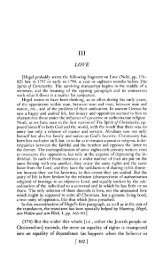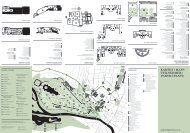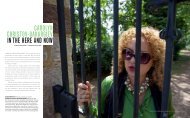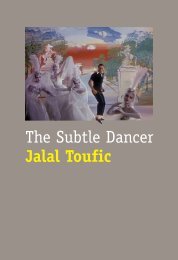A Conversation between Anna Maria Maiolino and Helena Tatay
A Conversation between Anna Maria Maiolino and Helena Tatay
A Conversation between Anna Maria Maiolino and Helena Tatay
- No tags were found...
You also want an ePaper? Increase the reach of your titles
YUMPU automatically turns print PDFs into web optimized ePapers that Google loves.
55): Deleuze says that artists develop ‘percepts’, which are combinations of sensations <strong>and</strong>perceptions that survive those who experience them. The coincidence <strong>between</strong> your ‘percepts’,<strong>and</strong> the concepts developed by Deleuze, like difference <strong>and</strong> repetition, is amazing. Had you readDeleuze?I read him in 1997 because my son Micael introduced me to him. First I read Difference <strong>and</strong>Repetition, <strong>and</strong> I felt it was very close <strong>and</strong> very intimate. Then I read his other books. To me it is clearthat, intuitively, I have developed a work that is very close to his philosophy. On the other h<strong>and</strong>, hisphilosophy is very close to life.56): Your work has also been related to Eva Hesse. Did you know her work? Did you see itwhen you lived in New York from 1968 to 1971?I can’t remember if I saw her work when I was living in New York, because at that time ‘I lived yetdid not live in me’, with two small children, without any help or time. I saw her work years later, inpublications <strong>and</strong> exhibitions. There are confluences <strong>between</strong> her work <strong>and</strong> mine; they are ratherformal, like a certain phallic aspect that is visible in our work – at times Hesse seems to have a certainphallic irony – <strong>and</strong> also in the use of the series <strong>and</strong> the metaphors of the body. But as I said before,I’m indebted to Brazilian art. Now they’re showing works of Hesse that were found in her studio,made from 1966 to 1969. These precarious works reveal Hesse’s wish to arrive at a non-art, aquestion that was in the minds of many artists at that time. For instance, in 1966, Lygia Clark wasworking on her precarious <strong>and</strong> sensorial objects, in works like Natureza (Estrutura cega) [Nature(Blind Structure)], 1966–67; Pedra e ar (Stone <strong>and</strong> Air), 1966; Respire conmigo (Breath with Me),1966; Diálogo de mãos (Dialogue with H<strong>and</strong>s), 1966. This last one consists of a Moebius elastic b<strong>and</strong>tied to the wrists of the participants, <strong>and</strong> these participants establish a dialogue with the movements oftheir h<strong>and</strong>s. I mention these works by Lygia because, together with ‘the nostalgia of the body’ that shetalked about so much, I think they really are the origin of the work I did after 1992, when I understoodthat the phenomena produced by the materials with which I work, as well as my own body, are the coauthorsof my work. A good example of what I’m saying is the series Codificações Matéricas (MatterCodifications), where the movements of the h<strong>and</strong>s on the paper, the drop of ink <strong>and</strong> the force ofgravity are the mediators in the realisation of the drawing. It is obvious that, formally, they havenothing to do with Lygia’s work, but they share some basic premises.57): And yet you do see a relation <strong>between</strong> your ephemeral installations <strong>and</strong> Arte Povera.The use of worthless, ephemeral materials, <strong>and</strong> the emphasis on aspects of the ritual <strong>and</strong> on manualwork, mean that there is something in common <strong>between</strong> these installations <strong>and</strong> Arte Povera. Also withthe metaphors that can be established with the pasta fatta in casa (home-made pasta), <strong>and</strong> with therelationship <strong>between</strong> the preparation of food <strong>and</strong> the fiesta <strong>and</strong> the ritual, which transform elementaryhuman situations into signs. On the other h<strong>and</strong>, when the segments of clay/earth are laid down on thefloor, there is an analogy with the ploughed fields, <strong>and</strong> with the marks of man <strong>and</strong> his culture.58): In the drawings of the nineties, as in those of the seventies, you don’t use traditionalmethods either. These series, which are always open, are elaborated with repeated gestures oractions, like moving the paper so the drop of ink sliding on it can do the drawing, as in Marcasda Gota <strong>and</strong> Codificações Matéricas; or sewing giving priority to the tactile, looking onlyoccasionally, while you draw on both sides of the paper, as in Indícios (Traces); or to elaborate‘families’ of drawings using the common marks that you leave while painting on Japanesepaper, as in Vestígios. In all these series of drawings, the result is as important as the process.What I do is to keep the work process in the work. When I’m drawing like that I think of seriality, <strong>and</strong>I realise that it is to do with basic tensions: one brings the other, announces the next one, which isrepeated but will always be another.Since 1993, when I began the series of work on the ‘h<strong>and</strong>s that make’, <strong>and</strong> until now, I have opted for








